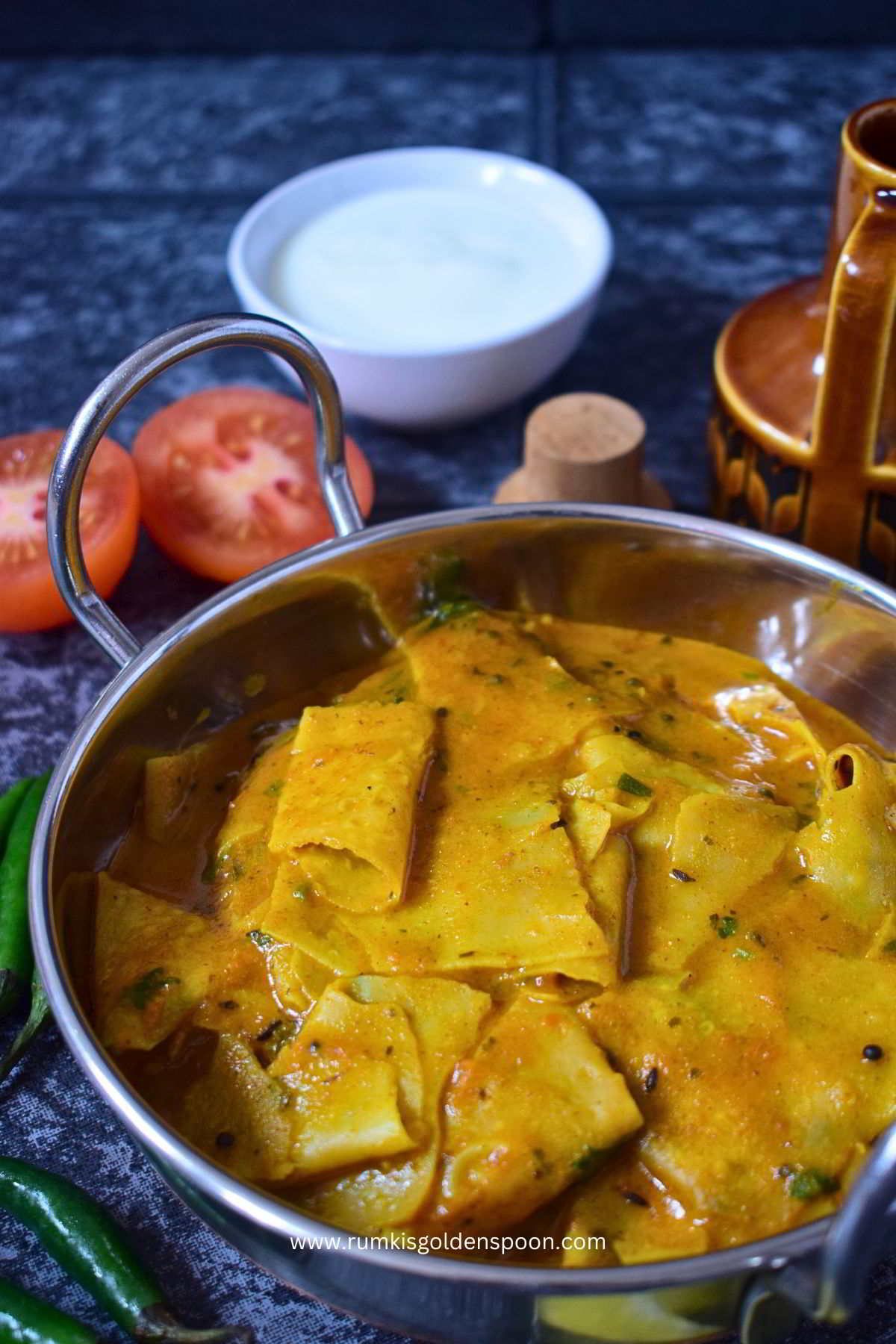Rajasthani papad ki sabji aka papad ki sabzi recipe is a Rajasthani delicacy and one of the popular vegetarian curries in the sub continents of India. It is a spicy, flavoured tangy curry that is frequently prepared in Rajasthani households, especially in dry seasons when fresh vegetables are not readily available. In this preparation, roasted papads are simmered in spicy tomato-yogurt-based gravy. Papad ki sabji is mostly relished with flatbread like rotis and parathas but can be accompanied by rice items like steamed rice, jeera rice, etc.
Papad is one of the most versatile elements which are used in myriad Indian food. Fried or roasted, papad is normally served as a side with a meal. A gravy preparation with papad may be unusual for many but for Marwari people, it’s a staple food. In this recipe, I have used urad dal papad with black peppers.
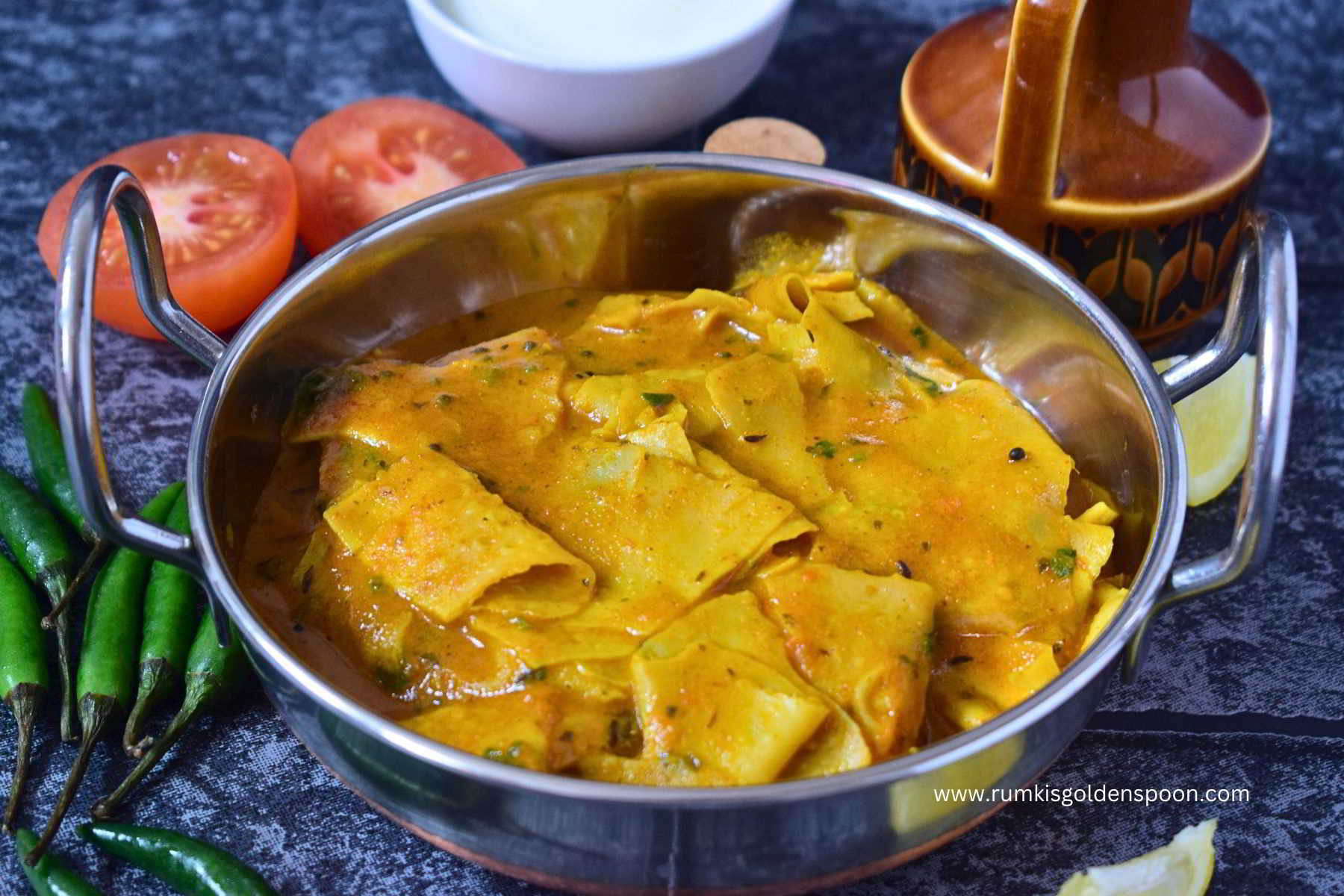
Table of Contents
About the recipe
Frequently Asked Questions
How to make Papad ki sabji (step wise photos)
Recipe Card
What is Papad ki sabji?
Papad ki sabji is a Hindi name and its name itself explains the dish.
Papad is basically sun-dried thin flat disc-shaped dough prepared with gram flour aka besan or rice flour, tapioca, or other lentils. It is normally either roasted or deep-fried till crispy. There are varieties of papad that are easily available in the market with different tastes and flavours.
Sabji means curry. In short, the recipe means a curry prepared with papad.
Rajasthani cuisine is a royal cuisine influenced by Rajputs. This cuisine has an expertise in long-lasting food that can be consumed without heating. This kind of food is suitable for the arid region. So, Rajasthani food is rich with huge ranges of succulent pickles, chutneys, papads and snacks. Rajasthani cuisine contains different varieties of food including non-vegetarian dishes, vegetarian dishes, and even Jain dishes which are no onion no garlic recipes.
The first time I tasted Rajasthani papad ki sabji was in my college hostel. One of my Marwari roommates had brought this spicy delight from her home and offered me to have some. I just loved the preparation. I got to know about the recipe in detail for her.
Papad ki sabzi recipe is a complete life saviour for busy moms too. Whenever you are running short of time or you have no vegetables in your fridge, Rajasthani papad ki sabji can be an ideal solution for these situations. In fact, if you don’t have tomatoes then you can only use yogurt for the gravy and prepare the curry without using a single vegetable. It is a perfect lunchbox recipe that you can pack with a pair of chapatis or parathas for your kids. Most of the kids like this flavoured curry and enjoy their tiffin thoroughly.
Papad ki sabji has the tendency to absorb the gravy. So you can prepare the gravy and keep it. Just roast or deep fry the papad, break them into pieces, add the papad to the gravy, and mix it before serving.
Papad ki sabzi recipe is a very easy recipe. The difficulty level of cooking this recipe is very low which is perfect for beginners. It gets prepared with very common ingredients that are easily available in any Indian Kitchen pantry. The best part of this effortless recipe is that it gets prepared very quickly without investing much time.
Ingredients for Papad ki sabji
Papad: The primary ingredient which provides taste, texture, and flavour to the dish.
Ginger paste: This is one of the most common ingredients used to flavour Indian curries.
Tomato: The addition of tomatoes adds a slight tanginess and enhances the taste of the dish.
Green chillies: It adds a heaty taste and refreshing flavour to the dish.
Herbs: Coriander leaves and dried fenugreek leaves aka kasuri methi are used at the final stage of cooking the curry. Both herbs are very important to flavour the dish.
Whole spices & hing: Add whole spices like cumin seeds, mustard seeds, dry red chillies, and hing aka asafoetida into the oil for tempering. These spices induce a nice aroma to the dish. So, try not to skip any of these whole spices.
Ground spices: Other than whole spices, I have used ground spices turmeric powder, red chilli powder, cumin powder, coriander powder, and garam masala powder for the recipe. All the spices help to develop a nice flavour and taste for the dish.
Salt: The most important ingredient that adds saltiness to the dish.
Oil or clarified butter: You can use either ghee or oil to cook this dal. It’s completely up to you. I have used oil to keep the recipe vegan-friendly.
Water: Water is used to adjust the consistency of the gravy.
Papad ki sabzi with step-by-step photos and instructions have been provided in the ‘Instructions’ section of the recipe. But before jumping into the recipe, I would like to share a few interesting facts about the recipe.
Frequently asked Questions
What type of papad works best for the recipe?
Any kind of papad can be used for the recipe. But according to me, urad dal papad, moong dal papad, or the mixture of urad dal and moong dal papad works best for the recipe. You can use a plain, mild or spicy variety of papad according to your own preference.
Shall I deep fry the papad?
It’s completely up to you. You can roast the papad on the gas hob, microwave it, or deep fry it. Other than these options, you can choose my way to roast the papad on tawa with a little bit of oil.
Can I skip yogurt from the recipe?
Yes, of course. You can skip the yogurt from the recipe if you don’t like the tangy taste.
Can I skip tomatoes from the recipe?
Yes, you can. But I must say that the addition of tomato enhances the taste and texture of the gravy.
How to make Papad ki sabji?
To prepare the papad ki sabji recipe, first put a pan on flame and allow it to become completely dry. Brush ½ teaspoon of oil on the pan. Turn the flame to medium and add the papad to the pan. Brush ½ teaspoon oil on the top side of the papad.
Press the papad with a spatula on a regular basis so it gets roasted evenly. Roast the papad from both sides till it becomes crunchy and brown spots occur. It takes around 2-3 minutes to roast one papad. Keep the papad aside on a separate plate and repeat the process to roast the other papads. Break them into small pieces and keep them aside.
Then take yogurt into a bowl and add some all-purpose flour into it. Whisk the yogurt thoroughly with a fork and keep it aside.
Add tomato chunks, green chillies, peeled ginger pieces into a jar of a grinder and close the lid. Pulse it to a smooth paste and keep it aside.
Now put a pan on flame and allow it to become completely dry. Then add oil into the pan and once the oil is hot, add cumin seeds, mustard seeds, dried red chilli, hing into the pan for tempering and allow them to crackle.
Add the tomato paste to the pan and give a nice mix. Cook it on low flame for 2-3 minutes.
Then add turmeric powder, red chilli powder, cumin powder, coriander powder and give a nice mix. Cook it on low flame for another 2-3 minutes until the masala releases oil.
Add green chillies, yogurt into the pan and mix it well. Cook it on low flame for 1-2 minutes.
Add water to the pan and give a nice stir. Turn the flame high and allow the gravy to boil.
Then turn the flame low and add salt, garam masala and kasuri methi, one by one into the pan. Mix it well.
Then add the broken roasted papad into the pan and mix it well. Cook it over low flame for a minute.
Add chopped coriander leaves into the pan and mix it well. Switch off the flame and papad ki sabji is ready to serve now.
Many Indian curry recipe have already been shared in my previous posts. You can check a few of them like
Kadai broccoli
Baby corn masala
Spicy mushroom curry
Capsicum onion tomato sabji
Palak matar
..And Many more…
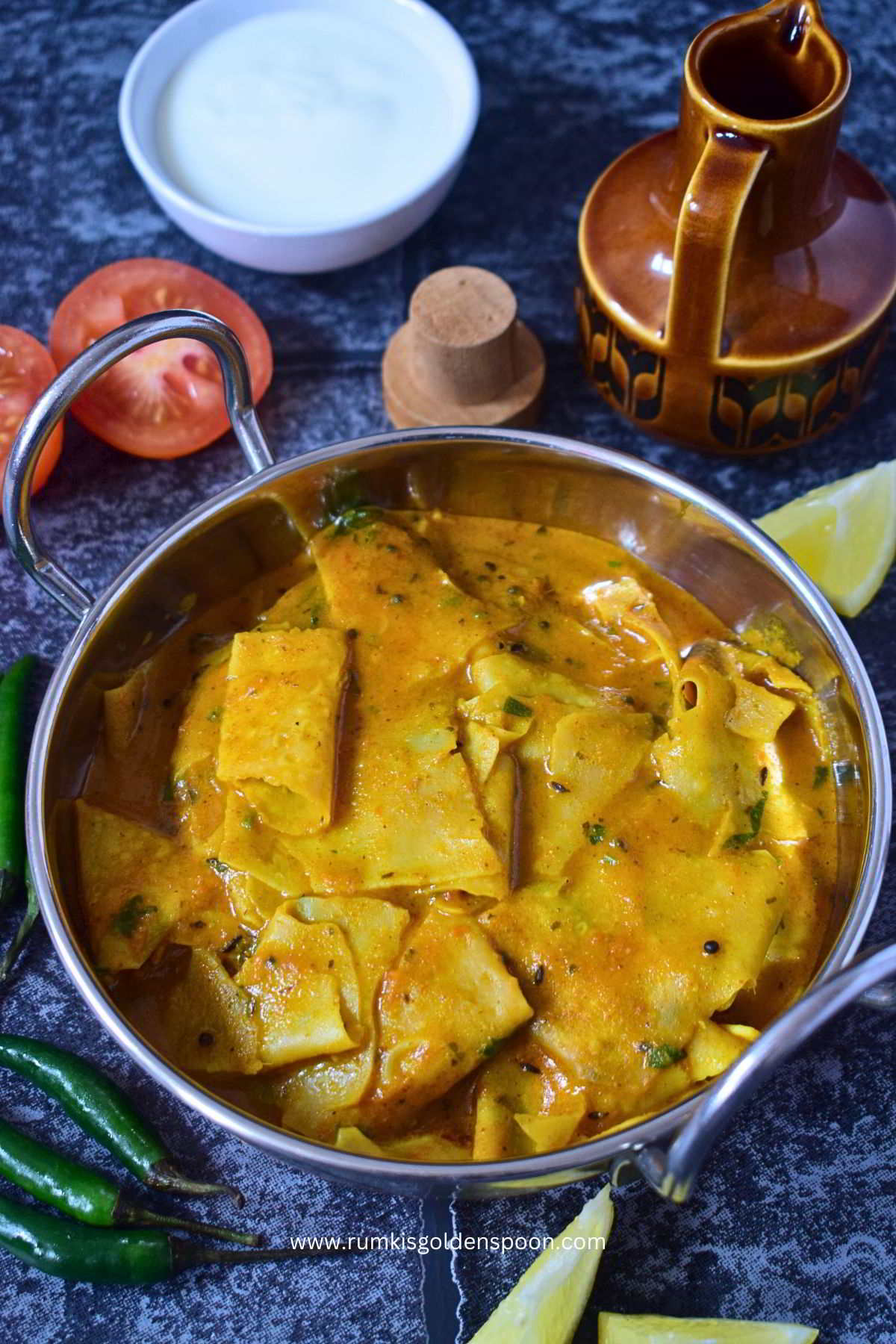
Ingredients:
1 cup = 250 ml
For the paste
- 2 Tomatoes
- 1 inch Ginger
- 2 green Chillies
For yogurt mixture
- 3 tablespoons Yogurt, at room temperature
- 1 teaspoon Maida aka all-purpose Flour
Other ingredients for papad ki sabji
- 4 roasted Papads
- 3 tablespoons chopped Coriander leaves
- 2-3 green Chillies
- ½ teaspoon Cumin seeds
- ½ teaspoon Mustard seeds
- 2-3 dry red Chillies
- ¼ teaspoon Hing aka Asafoetida
- ½ teaspoon Turmeric powder
- 1 teaspoon Chilli powder
- 1 teaspoon Coriander powder
- ½ teaspoon Garam masala powder
- 1 teaspoon Kasuri methi aka dried fenugreek leaves
- Salt to taste
- 1 cup Water for gravy
- 4 teaspoons Oil to roast the papad
- 1 tablespoon Oil to cook the gravy
Instructions:
- First, put a pan on flame and allow it to become completely dry. Brush ½ teaspoon of oil on the pan.
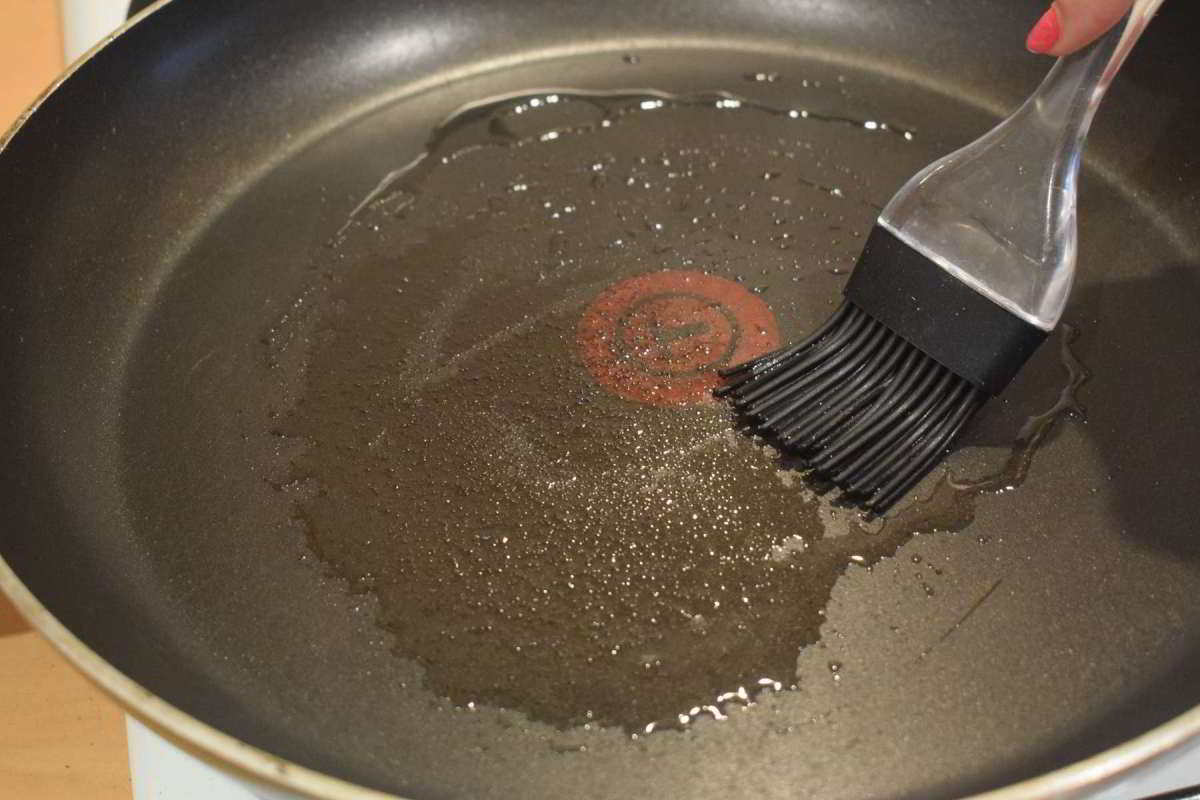
- Turn the flame to medium and add the papad to the pan. Brush ½ teaspoon oil on the top side of the papad.
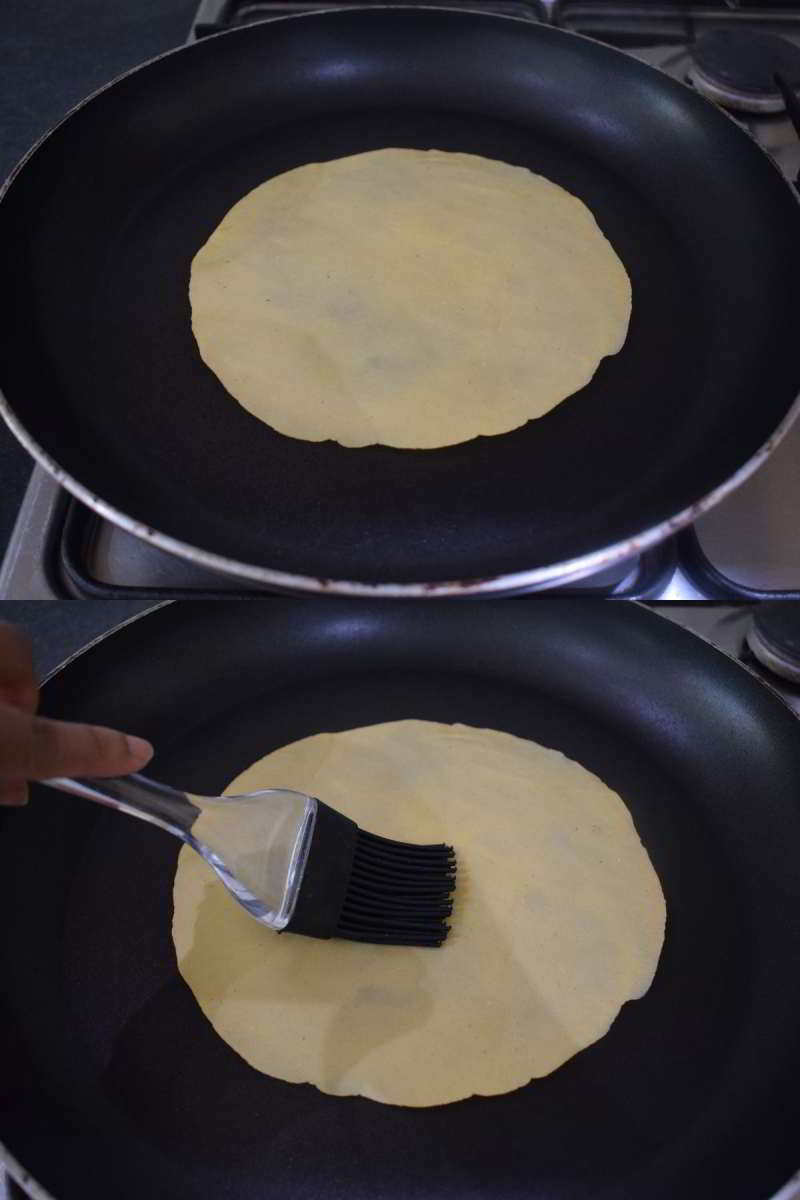
- Press the papad with a spatula on a regular basis so that it gets roasted evenly. Roast the papad from both sides till it becomes crunchy and brown spots occur. It takes around 2-3 minutes to roast one papad.
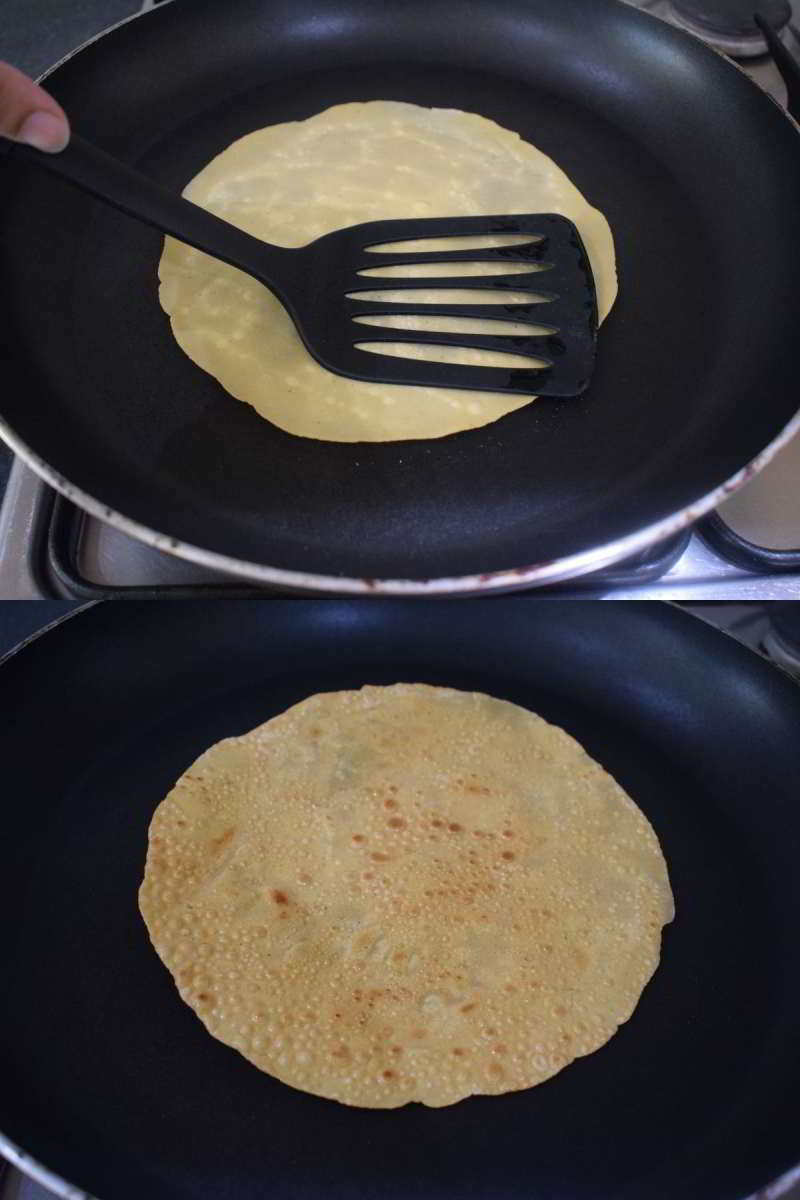
- Keep the papad aside on a separate plate and repeat the process to roast the other papads. Break them into small pieces and keep them aside.
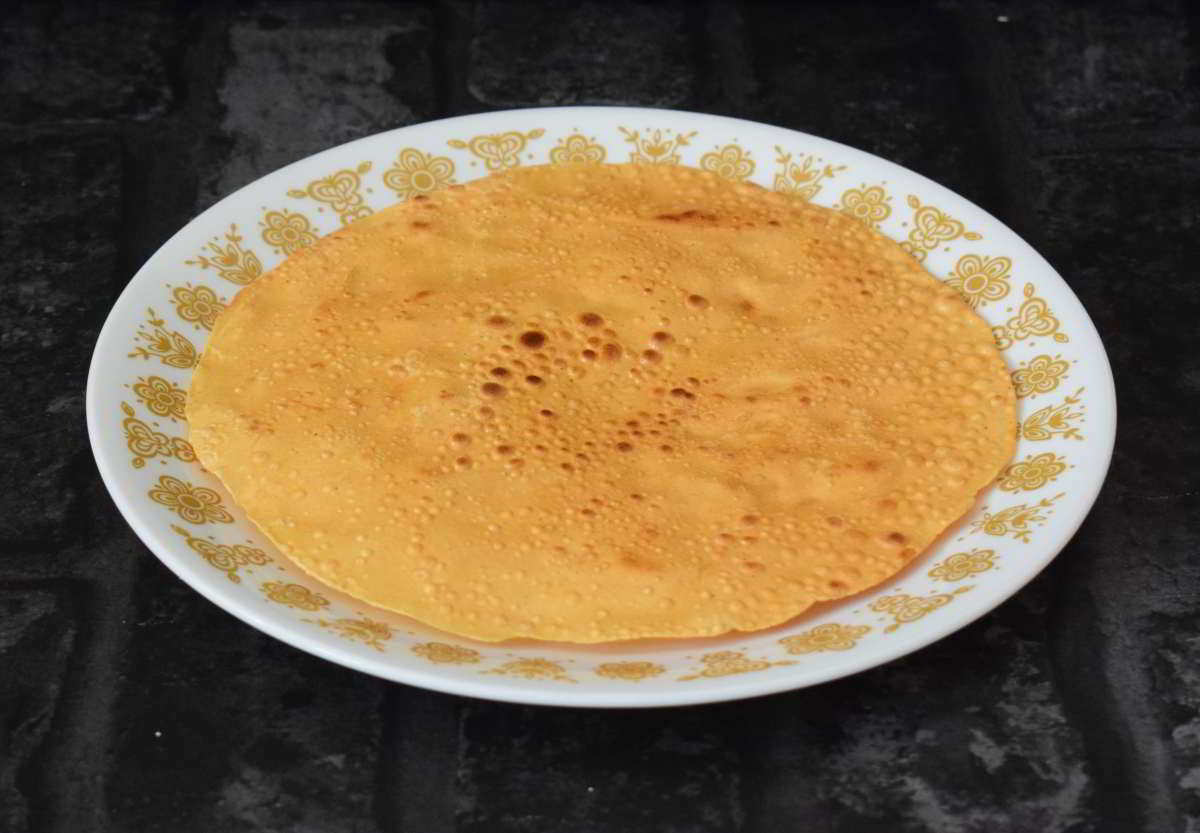
- Take 3 tablespoons of yogurt into a bowl and add 1 teaspoon of all-purpose flour into it. Whisk the yogurt thoroughly with a fork and keep it aside.
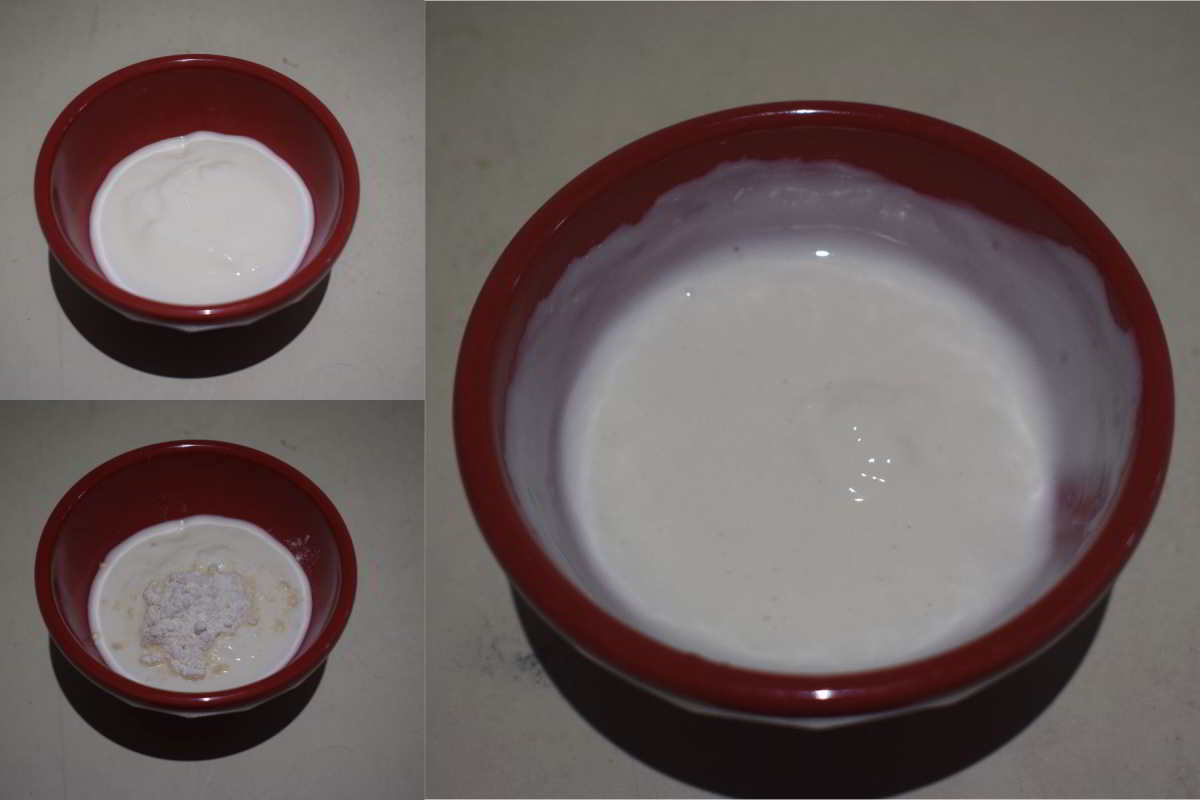
- Add tomato chunks, 2 green chillies, 1 inch peeled ginger pieces into a jar of a grinder and close the lid. Pulse it to a smooth paste and keep it aside.
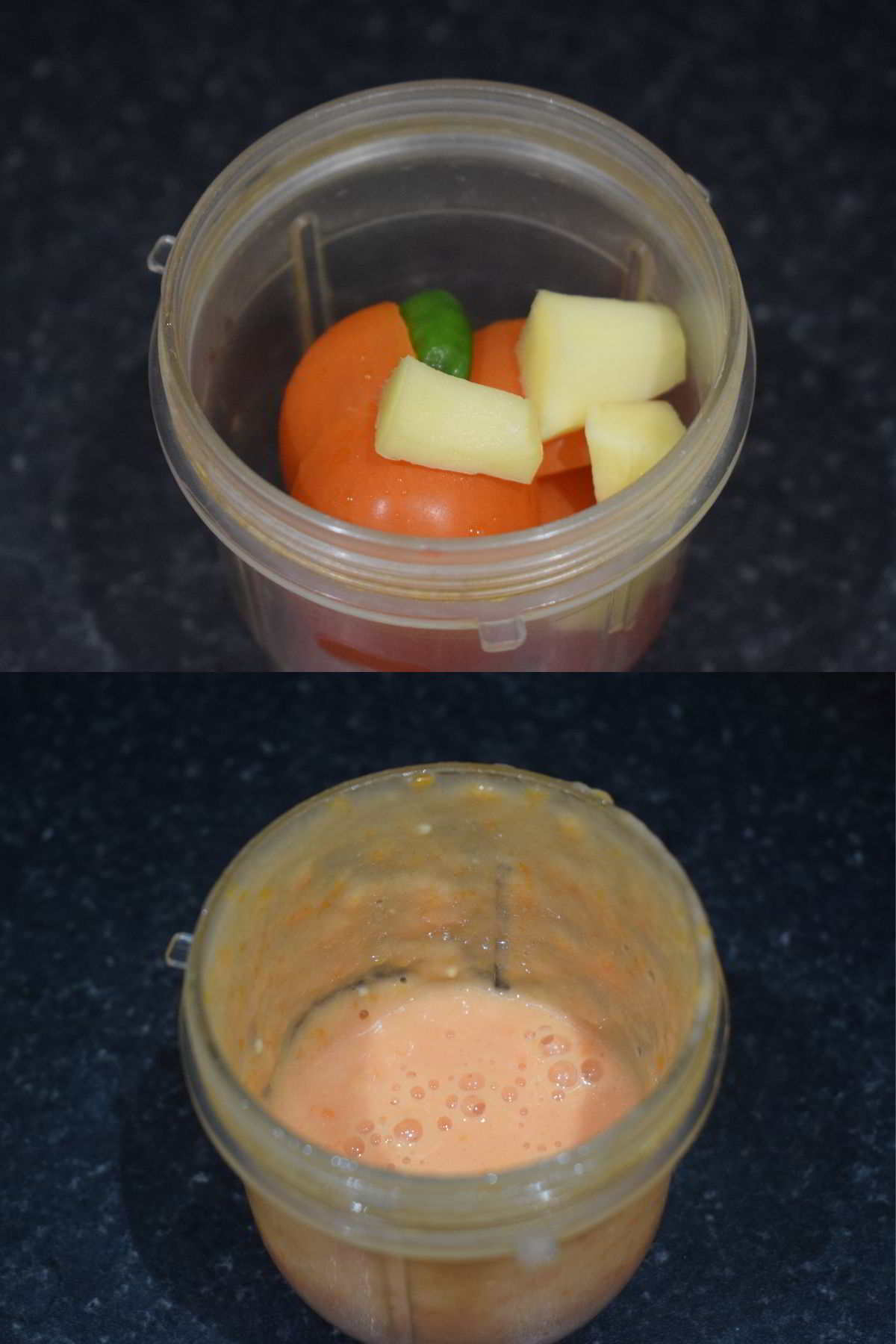
- Now put a pan on flame and allow it to become completely dry. Then add 1 tablespoon oil into the pan.
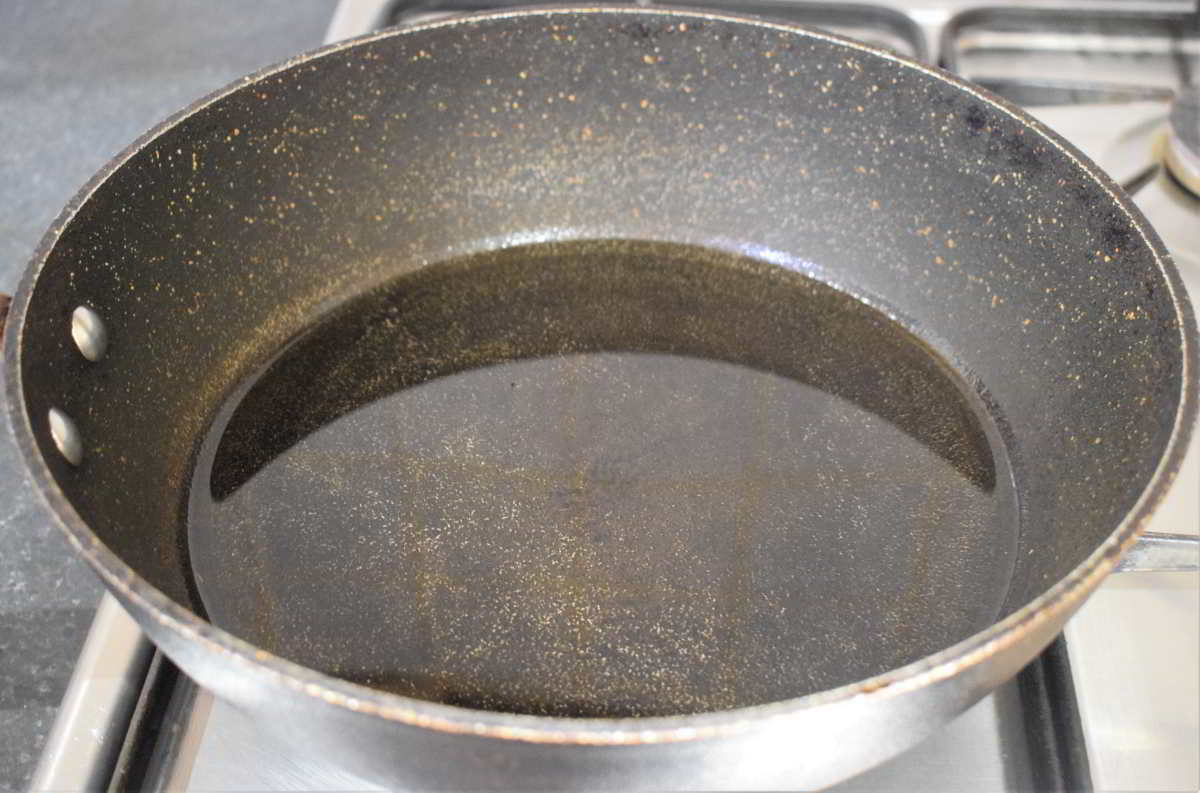
- Once the oil is hot, add ½ teaspoon cumin seeds, ½ teaspoon mustard seeds, 2 dried red chilli, ¼ teaspoon hing into the pan for tempering and allow them to crackle.
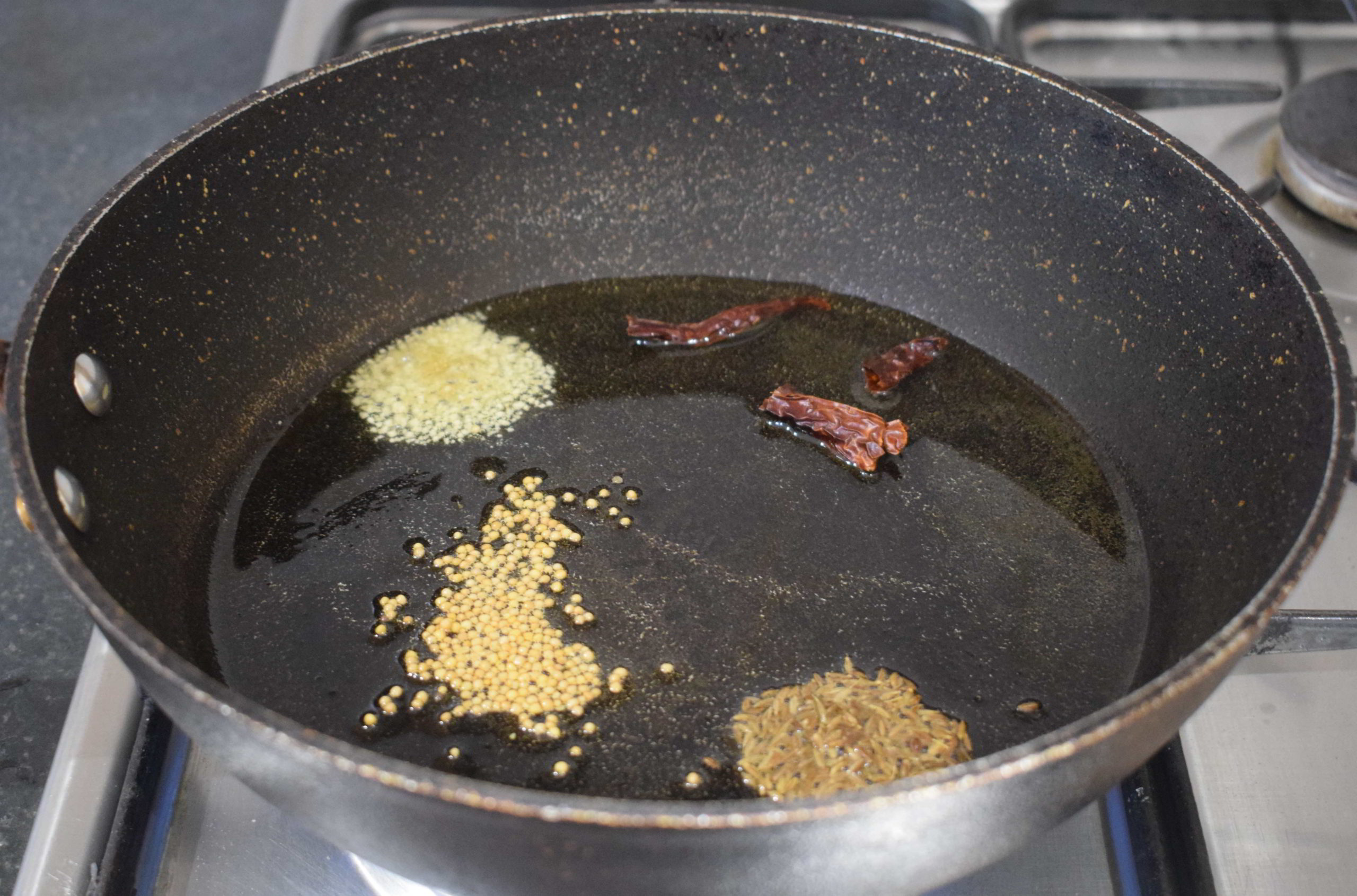
- Add the tomato paste to the pan and give a nice mix. Cook it on low flame for 2-3 minutes.
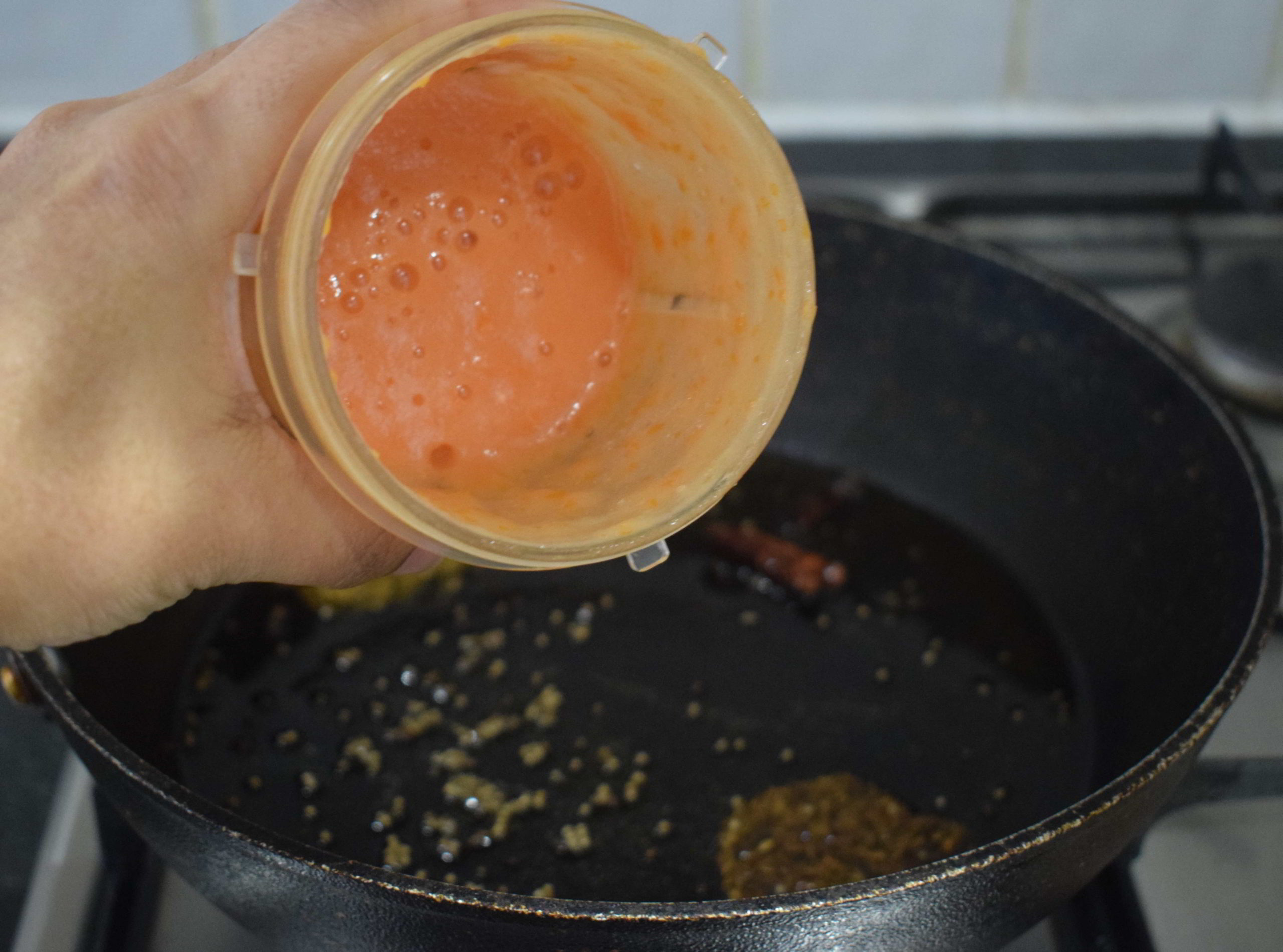
- Add ½ teaspoon turmeric powder, 1 teaspoon red chilli powder, 1 teaspoon coriander powder and give a nice mix. Cook it on low flame for another 2-3 minutes until the masala releases oil.
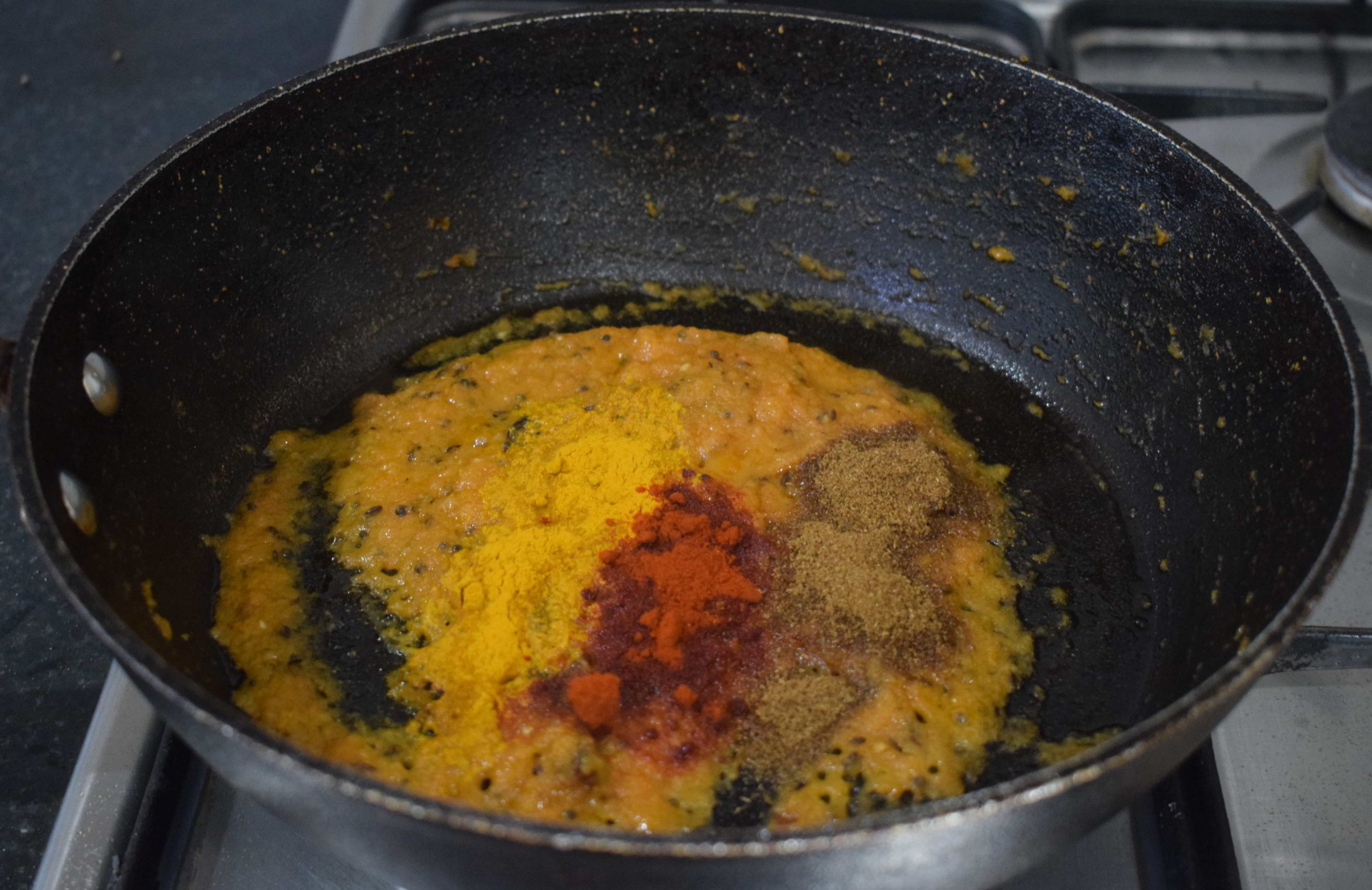
- Add 2-3 green chillies, yogurt (Step 5) into the pan and mix it well. Cook it on low flame for 1-2 minutes.
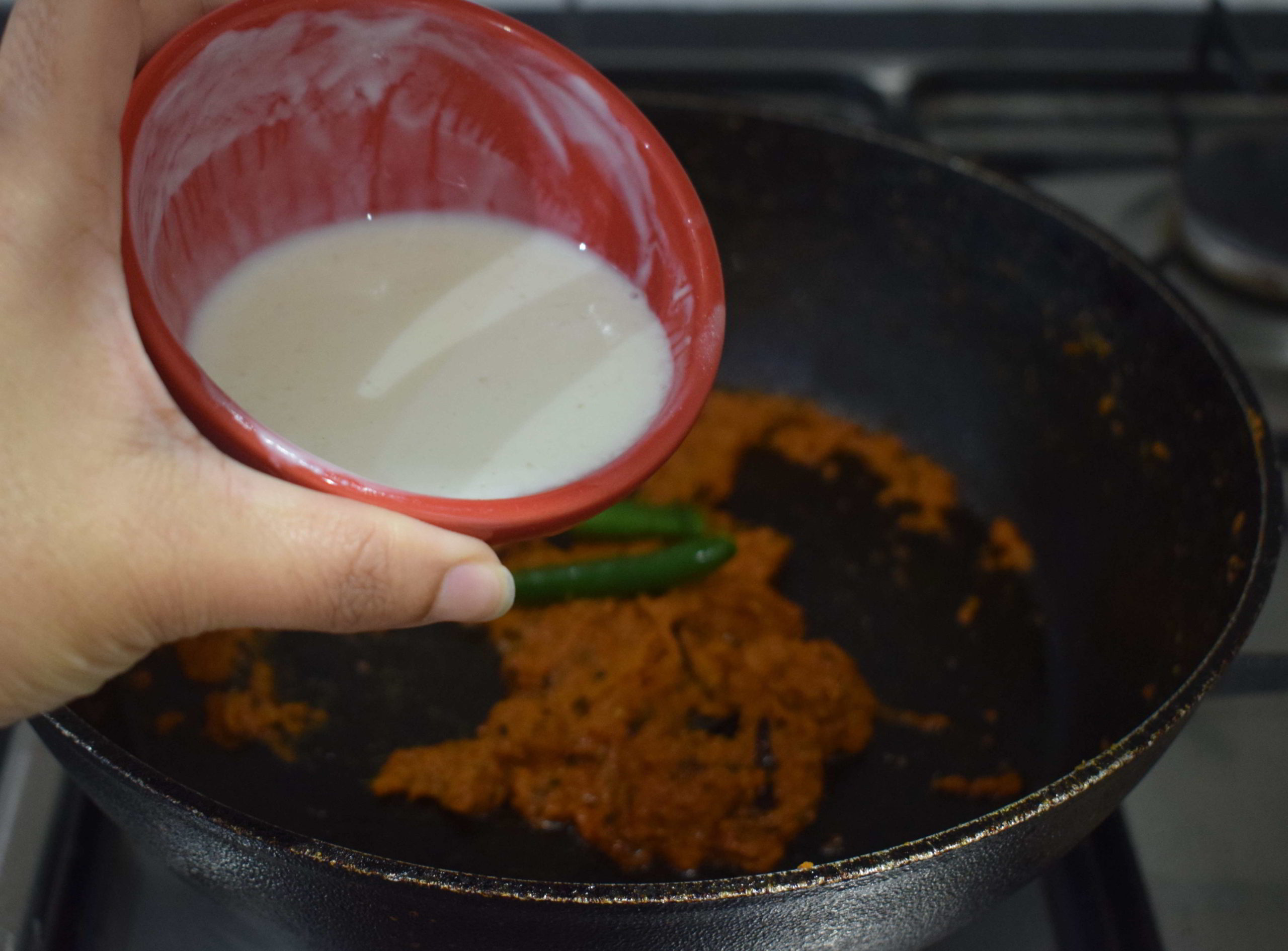
- Add 1 cup water to the pan and give a nice stir. Turn the flame high and allow the gravy to boil.
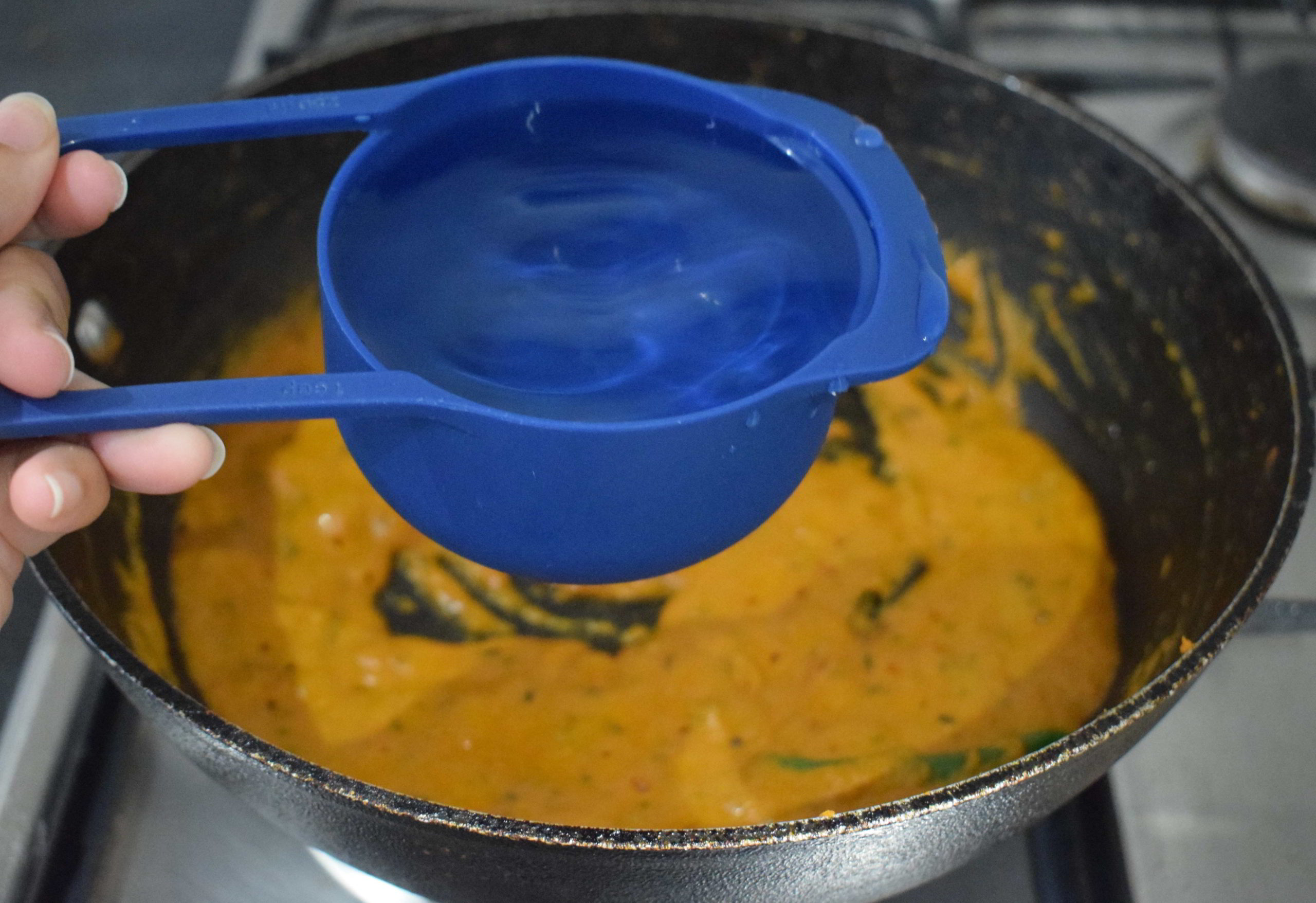
- Turn the flame low and add salt, ½ teaspoon garam masala and 1 teaspoon kasuri methi, one by one into the pan. Mix it well.
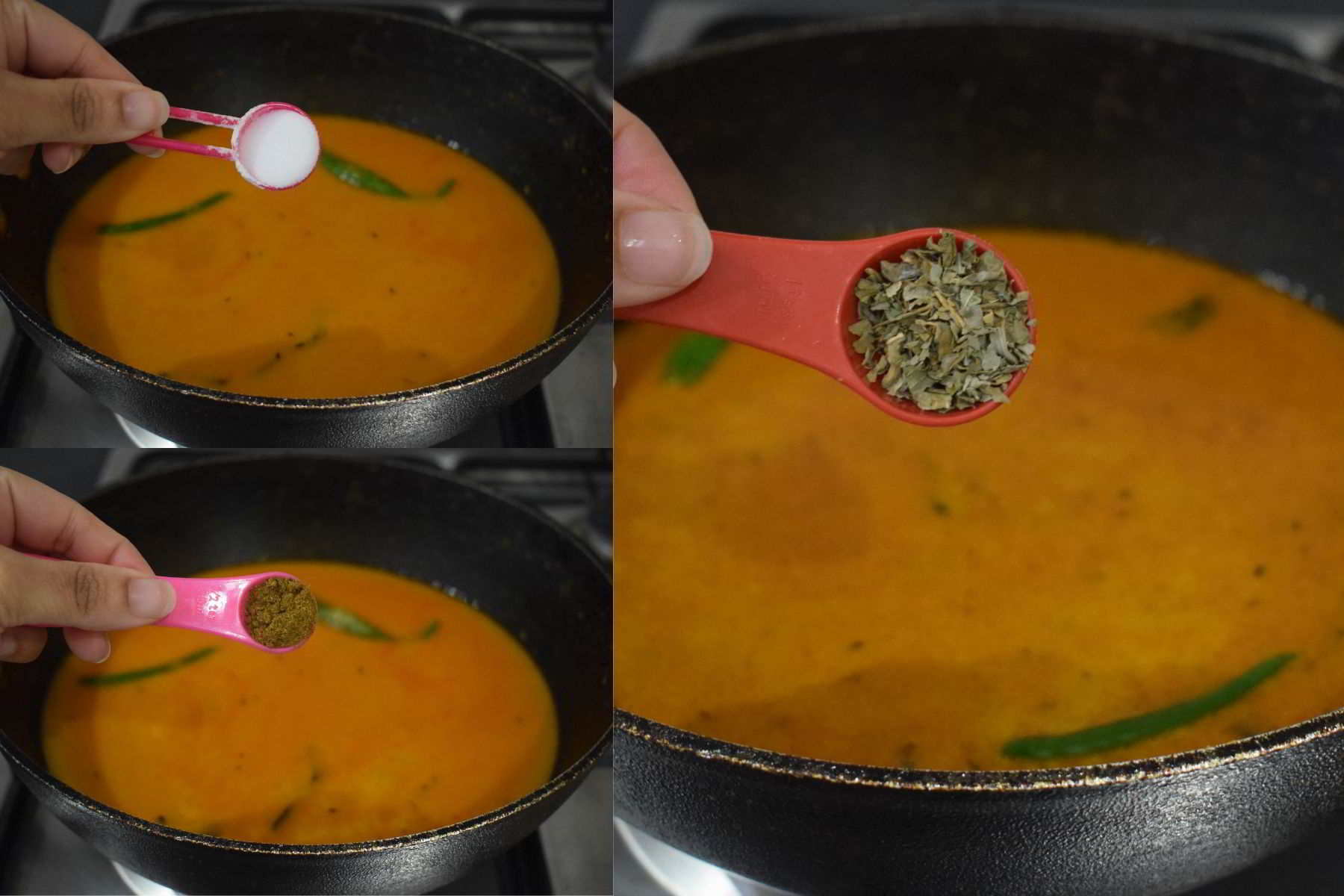
- Add the broken roasted papad into the pan and mix it well. Cook it over low flame for a minute.
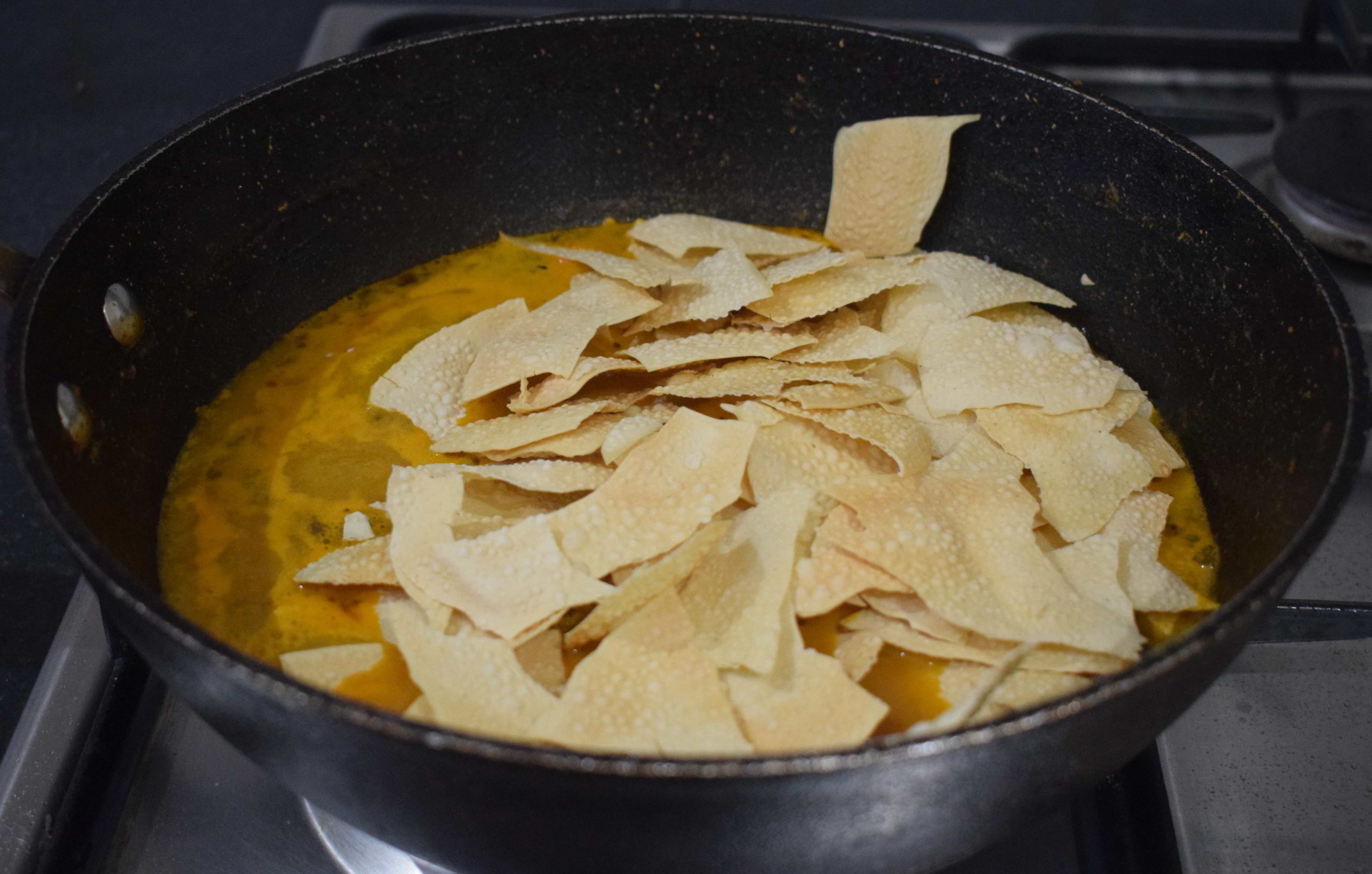
- Add 3 tablespoons chopped coriander leaves into the pan and mix it well.
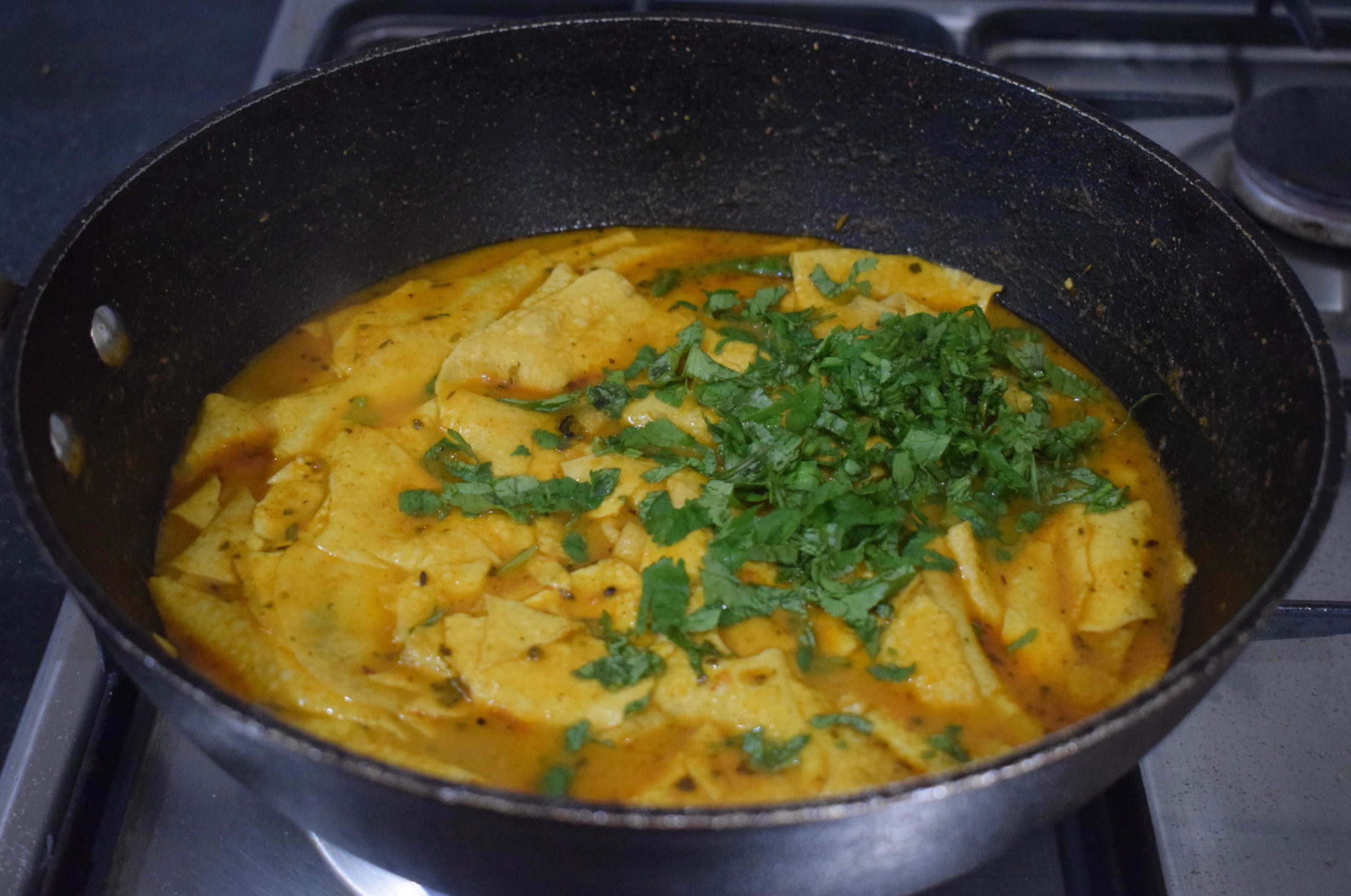
- Switch off the flame and papad ki sabji is ready to serve now.
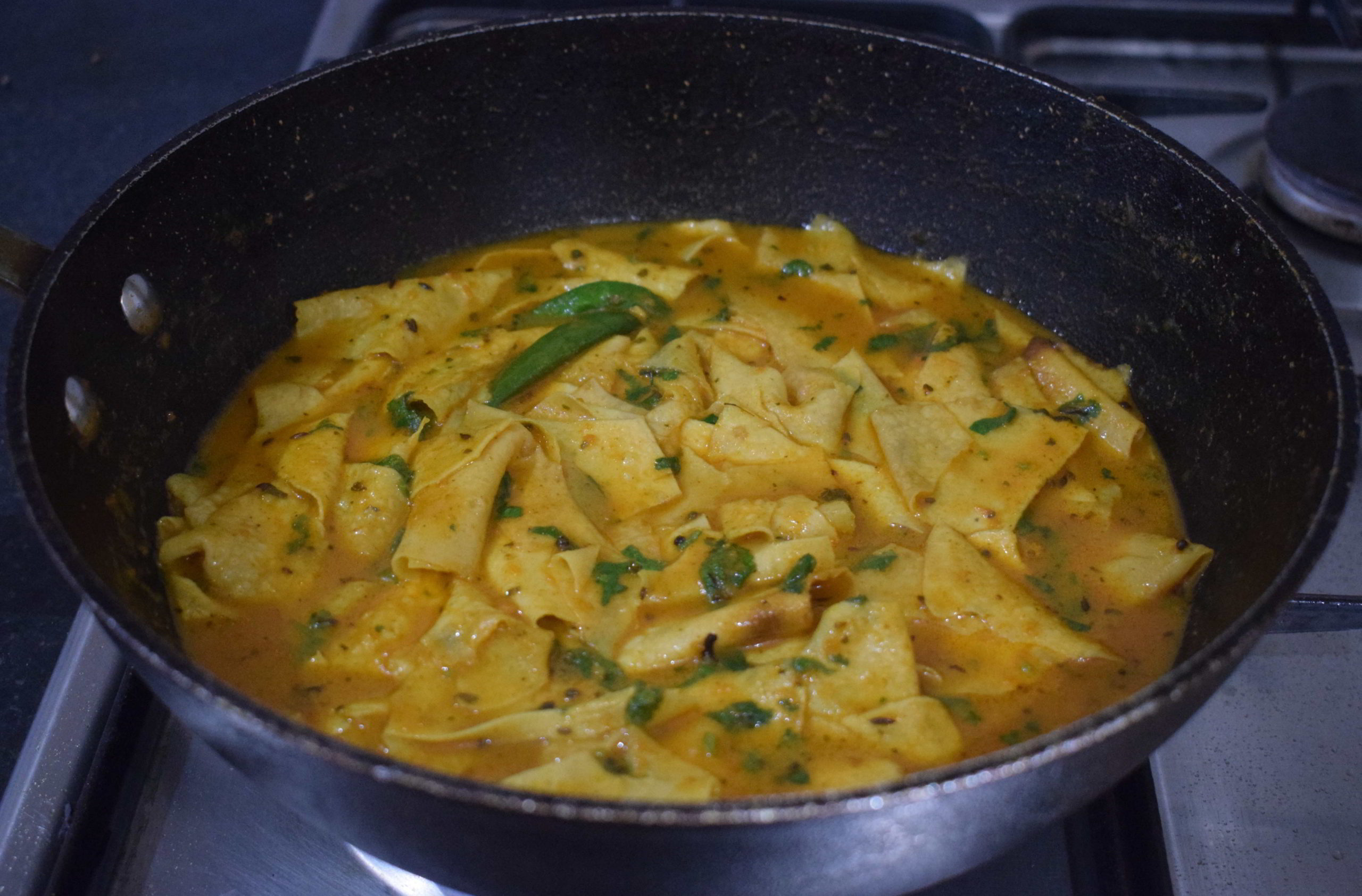
Serving Instruction
Transfer the Rajasthani papad ki sabji into a serving bowl or on a serving plate. Serve hot or warm to enjoy the best taste. Pair up the delectable curry with any Indian flatbread or rice item and enjoy your comfort meal.
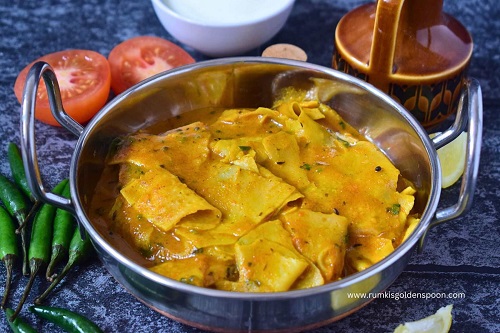
Ingredients
1 cup = 250 ml
For the paste
- 2 Tomatoes
- 1 inch Ginger
- 2 green Chillies
For yogurt mixture
- 3 tablespoons Yogurt, at room temperature
- 1 teaspoon Maida aka all-purpose Flour
Other ingredients for papad ki sabji
- 4 roasted Papads
- 3 tablespoons chopped Coriander leaves
- 2-3 green Chillies
- ½ teaspoon Cumin seeds
- ½ teaspoon Mustard seeds
- 2-3 dry red Chillies
- ¼ teaspoon Hing aka Asafoetida
- ½ teaspoon Turmeric powder
- 1 teaspoon Chilli powder
- 1 teaspoon Coriander powder
- ½ teaspoon Garam masala powder
- 1 teaspoon Kasuri methi aka dried fenugreek leaves
- Salt to taste
- 1 cup Water for gravy
- 4 teaspoons Oil to roast the papad
- 1 tablespoon Oil to cook the gravy
Instructions
- First, put a pan on flame and allow it to become completely dry. Brush ½ teaspoon of oil on the pan.
- Turn the flame to medium and add the papad to the pan. Brush ½ teaspoon oil on the top side of the papad.
- Press the papad with a spatula on a regular basis so that it gets roasted evenly. Roast the papad from both sides till it becomes crunchy and brown spots occur. It takes around 2-3 minutes to roast one papad.
- Keep the papad aside on a separate plate and repeat the process to roast the other papads. Break them into small pieces and keep them aside.
- Take 3 tablespoons of yogurt into a bowl and add 1 teaspoon of all-purpose flour into it. Whisk the yogurt thoroughly with a fork and keep it aside.
- Add tomato chunks, 2 green chillies, 1 inch peeled ginger pieces into a jar of a grinder and close the lid. Pulse it to a smooth paste and keep it aside.
- Now put a pan on flame and allow it to become completely dry. Then add 1tablespoon oil into the pan.
- Once the oil is hot, add ½ teaspoon cumin seeds, ½ teaspoon mustard seeds, 2 dried red chilli, ¼ teaspoon hing into the pan for tempering and allow them to crackle.
- Add the tomato paste to the pan and give a nice mix. Cook it on low flame for 2-3 minutes.
- Add ½ teaspoon turmeric powder, 1 teaspoon red chilli powder, 1 teaspoon coriander powder and give a nice mix. Cook it on low flame for another 2-3 minutes until the masala releases oil.
- Add 2-3 green chillies, yogurt (Step 5) into the pan and mix it well. Cook it on low flame for 1-2 minutes.
- Add 1 cup water to the pan and give a nice stir. Turn the flame high and allow the gravy to boil.
- Turn the flame low and add salt, ½ teaspoon garam masala and 1 teaspoon kasuri methi, one by one into the pan. Mix it well.
- Add the broken roasted papad into the pan and mix it well. Cook it over low flame for a minute.
- Add 3 tablespoons chopped coriander leaves into the pan and mix it well.
- Switch off the flame and papad ki sabji is ready to serve now.

